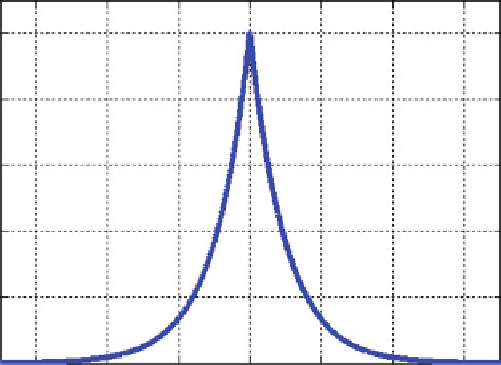Digital Signal Processing Reference
In-Depth Information
where
P
X
(
k
;
t
) is the Poisson formula given in (
6.71
).
Similarly, the amplitudes of random variables
X
1
and
X
2
will have opposite
signs, if there are an odd number of zero crossings in the interval
t
:
PfX
2
¼ UjX
1
¼U
;
tg¼PfX
2
¼UjX
1
¼ U
;
tg
¼
1
k¼
1
(6.76)
P
X
ðk
;
tÞ:
;
3
;
5
;
...
Finally, from (
6.72
)to(
6.76
), we get:
k
k
1
1
l
j
t
ðÞ
l
j
t
ðÞ
e
ljtj
U
2
e
ljtj
R
XX
ðtÞ¼U
2
k
!
k
!
k¼
0
;
2
;
4
;
...
k¼
1
;
3
;
5
;
...
"
#
:
(6.77)
k
k
¼ U
2
e
ljtj
1
k¼
0
1
l
j
t
ðÞ
ljtðÞ
¼ U
2
e
2
ljtj
k
!
k
!
;
2
;
4
;
...
k¼
1
;
3
;
5
;
...
Note that in the obtained result we have an absolute value of
t
because the time
interval
t
in the Poisson formula (
6.71
) is always positive, while in an autocorrelation
function time interval
t
takes all values from
1
until +
1
.
The autocorrelation function is shown in Fig.
6.10
for
U ¼
1 and
l ¼
0.5.
Next we verify the properties of the autocorrelation function for
U ¼
1:
P.1
The autocorrelation function has its maximum value at
t ¼
0, and it is equal to
U
2
¼
1.
P.2
From (
6.77
), it is clear that the autocorrelation function is an even function,
i.e.,
R
XX
(
t
)
¼ R
XX
(
t
).
1
0.8
0.6
0.4
0.2
0
-
3
-
2
-
1
0
1
2
3
lt
Fig. 6.10
Autocorrelation function in Example 6.5.2


Search WWH ::

Custom Search